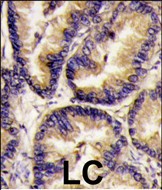VEGFB (VEGF2) Antibody (Center)
Purified Rabbit Polyclonal Antibody (Pab)
- SPECIFICATION
- CITATIONS
- PROTOCOLS
- BACKGROUND

Application
| IHC-P, WB, E |
|---|---|
| Primary Accession | P49765 |
| Other Accession | Q16528 |
| Reactivity | Human |
| Host | Rabbit |
| Clonality | Polyclonal |
| Isotype | Rabbit IgG |
| Calculated MW | 21602 Da |
| Antigen Region | 110-139 aa |
| Gene ID | 7423 |
|---|---|
| Other Names | Vascular endothelial growth factor B, VEGF-B, VEGF-related factor, VRF, VEGFB, VRF |
| Target/Specificity | This VEGFB (VEGF2) antibody is generated from rabbits immunized with a KLH conjugated synthetic peptide between 110-139 amino acids from the Central region of human VEGFB (VEGF2). |
| Dilution | IHC-P~~1:10~50 WB~~1:1000 E~~Use at an assay dependent concentration. |
| Format | Purified polyclonal antibody supplied in PBS with 0.09% (W/V) sodium azide. This antibody is prepared by Saturated Ammonium Sulfate (SAS) precipitation followed by dialysis against PBS. |
| Storage | Maintain refrigerated at 2-8°C for up to 2 weeks. For long term storage store at -20°C in small aliquots to prevent freeze-thaw cycles. |
| Precautions | VEGFB (VEGF2) Antibody (Center) is for research use only and not for use in diagnostic or therapeutic procedures. |
| Name | VEGFB |
|---|---|
| Synonyms | VRF |
| Function | Growth factor for endothelial cells. VEGF-B167 binds heparin and neuropilin-1 whereas the binding to neuropilin-1 of VEGF-B186 is regulated by proteolysis. |
| Cellular Location | Secreted. Note=Secreted but remains associated to cells or to the extracellular matrix unless released by heparin |
| Tissue Location | Expressed in all tissues except liver. Highest levels found in heart, skeletal muscle and pancreas |

Thousands of laboratories across the world have published research that depended on the performance of antibodies from Abcepta to advance their research. Check out links to articles that cite our products in major peer-reviewed journals, organized by research category.
info@abcepta.com, and receive a free "I Love Antibodies" mug.
Provided below are standard protocols that you may find useful for product applications.
Background
Vascular endothelial growth factors (VEGFs) are a family of closely related growth factors having a conserved pattern of eight cysteine residues and sharing common VEGF receptors. VEGFs stimulate endothelial cells, induce angiogenesis, promote cell migration, increase vascular permeability, and inhibit apoptosis. VEGFB has structural similarities to VEGF and PIGF and is frequently co-expressed with VEGF. There are two alternatively spliced isoforms of VEGFB: VEGFB 167 and VEGFB 186. VEGFB 167, a highly basic heparin-binding protein, remains with the cell or extracellular matrix whereas, VEGFB 186 is readily secreted. VEGFB stimulates endothelial cell proliferation. VEGFB binds to the tyrosine kinase receptor VEGFR1 (flt1) and does not bind to VEGFR2. Vascular Endothelial Growth Factor B is widely expressed but is most abundant in heart, skeletal muscle, and pancreas. It has been suggested that VEGFB expression in human primary breast cancers is associated with lymph node metastasis. The genes that encode VEGFB have been mapped to chromosome 11q13.
References
Trompezinski, S., et al., Exp. Dermatol. 13(2):98-105 (2004).
Qi, J.H., et al., Nat. Med. 9(4):407-415 (2003).
Joukov, V., et al., J. Cell. Physiol. 173(2):211-215 (1997).
Olofsson, B., et al., J. Biol. Chem. 271(32):19310-19317 (1996).
Olofsson, B., et al., Proc. Natl. Acad. Sci. U.S.A. 93(6):2576-2581 (1996).
If you have used an Abcepta product and would like to share how it has performed, please click on the "Submit Review" button and provide the requested information. Our staff will examine and post your review and contact you if needed.
If you have any additional inquiries please email technical services at tech@abcepta.com.













 Foundational characteristics of cancer include proliferation, angiogenesis, migration, evasion of apoptosis, and cellular immortality. Find key markers for these cellular processes and antibodies to detect them.
Foundational characteristics of cancer include proliferation, angiogenesis, migration, evasion of apoptosis, and cellular immortality. Find key markers for these cellular processes and antibodies to detect them. The SUMOplot™ Analysis Program predicts and scores sumoylation sites in your protein. SUMOylation is a post-translational modification involved in various cellular processes, such as nuclear-cytosolic transport, transcriptional regulation, apoptosis, protein stability, response to stress, and progression through the cell cycle.
The SUMOplot™ Analysis Program predicts and scores sumoylation sites in your protein. SUMOylation is a post-translational modification involved in various cellular processes, such as nuclear-cytosolic transport, transcriptional regulation, apoptosis, protein stability, response to stress, and progression through the cell cycle. The Autophagy Receptor Motif Plotter predicts and scores autophagy receptor binding sites in your protein. Identifying proteins connected to this pathway is critical to understanding the role of autophagy in physiological as well as pathological processes such as development, differentiation, neurodegenerative diseases, stress, infection, and cancer.
The Autophagy Receptor Motif Plotter predicts and scores autophagy receptor binding sites in your protein. Identifying proteins connected to this pathway is critical to understanding the role of autophagy in physiological as well as pathological processes such as development, differentiation, neurodegenerative diseases, stress, infection, and cancer.



